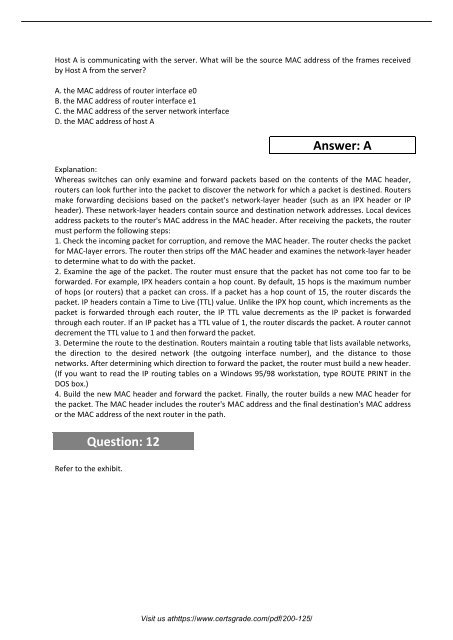200-125 Exam Questions
We offer you free sample questions along answers prepared by the professionals of the IT field. You can easily pass your 200-125 Test with our Training Kits. For more info please visit here: http://www.certsgrade.com/pdf/200-125/
We offer you free sample questions along answers prepared by the professionals of the IT field. You can easily pass your 200-125 Test with our Training Kits. For more info please visit here: http://www.certsgrade.com/pdf/200-125/
Create successful ePaper yourself
Turn your PDF publications into a flip-book with our unique Google optimized e-Paper software.
Host A is communicating with the server. What will be the source MAC address of the frames received<br />
by Host A from the server?<br />
A. the MAC address of router interface e0<br />
B. the MAC address of router interface e1<br />
C. the MAC address of the server network interface<br />
D. the MAC address of host A<br />
Answer: A<br />
Explanation:<br />
Whereas switches can only examine and forward packets based on the contents of the MAC header,<br />
routers can look further into the packet to discover the network for which a packet is destined. Routers<br />
make forwarding decisions based on the packet's network-layer header (such as an IPX header or IP<br />
header). These network-layer headers contain source and destination network addresses. Local devices<br />
address packets to the router's MAC address in the MAC header. After receiving the packets, the router<br />
must perform the following steps:<br />
1. Check the incoming packet for corruption, and remove the MAC header. The router checks the packet<br />
for MAC-layer errors. The router then strips off the MAC header and examines the network-layer header<br />
to determine what to do with the packet.<br />
2. <strong>Exam</strong>ine the age of the packet. The router must ensure that the packet has not come too far to be<br />
forwarded. For example, IPX headers contain a hop count. By default, 15 hops is the maximum number<br />
of hops (or routers) that a packet can cross. If a packet has a hop count of 15, the router discards the<br />
packet. IP headers contain a Time to Live (TTL) value. Unlike the IPX hop count, which increments as the<br />
packet is forwarded through each router, the IP TTL value decrements as the IP packet is forwarded<br />
through each router. If an IP packet has a TTL value of 1, the router discards the packet. A router cannot<br />
decrement the TTL value to 1 and then forward the packet.<br />
3. Determine the route to the destination. Routers maintain a routing table that lists available networks,<br />
the direction to the desired network (the outgoing interface number), and the distance to those<br />
networks. After determining which direction to forward the packet, the router must build a new header.<br />
(If you want to read the IP routing tables on a Windows 95/98 workstation, type ROUTE PRINT in the<br />
DOS box.)<br />
4. Build the new MAC header and forward the packet. Finally, the router builds a new MAC header for<br />
the packet. The MAC header includes the router's MAC address and the final destination's MAC address<br />
or the MAC address of the next router in the path.<br />
Question: 12<br />
Refer to the exhibit.<br />
Visit us athttps://www.certsgrade.com/pdf/<strong>200</strong>-<strong>125</strong>/

















